With versatility and flexibility, Emacs has become a popular text editing and manipulation tool among general users and professional developers. A customizable and easy-to-access text editor, Emacs is equipped with tools to find and replace data of string type. Thus, this article will provide an in-depth analysis of methods on how to find and replace text data (both words and patterns using regex) in Emacs. It will mention the useful keyboard shortcuts to accomplish such tasks. Moreover, it will mention GUI-based techniques to make your text-based search and replace operations smoother in Emacs.
1. Find String Using CTRL+S
The search feature is one of the powerful features in Emacs text editor that lets users search and find specific strings (keywords). To find a specific string in Emacs, press CTRL+S first. Then enter the string to search when prompted. If there’s a match or any matches, they will be highlighted, and the match with the current cursor position will be highlighted in purple like below: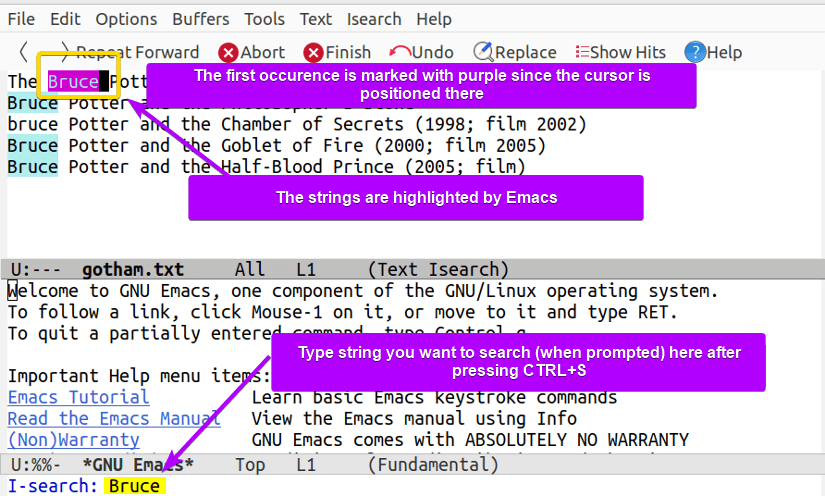 In addition, you can perform an incremental search with CTRL+S. To do so, press CTRL+S continuously to find and search through every occurrence one by one:
In addition, you can perform an incremental search with CTRL+S. To do so, press CTRL+S continuously to find and search through every occurrence one by one: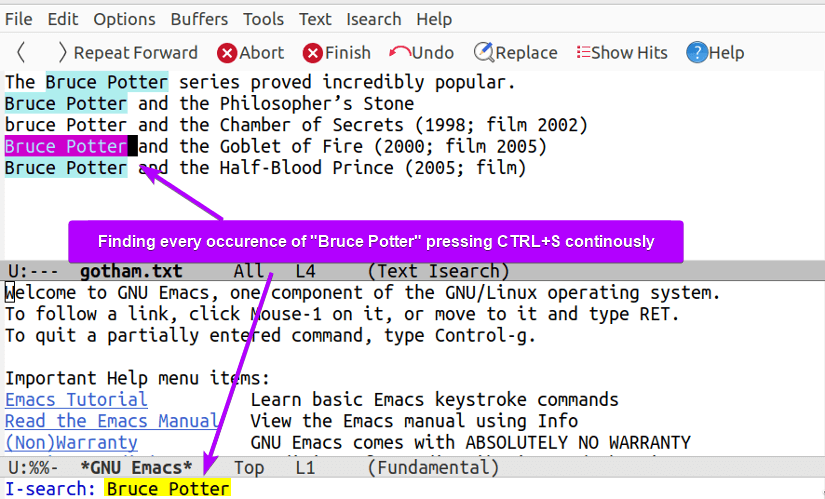
2. Find String with Backward Search Using CTRL+R
It is also possible to perform a backward search and thus find the intended string. To find a specific string via backward search press CTRL+R and enter the query string once prompted: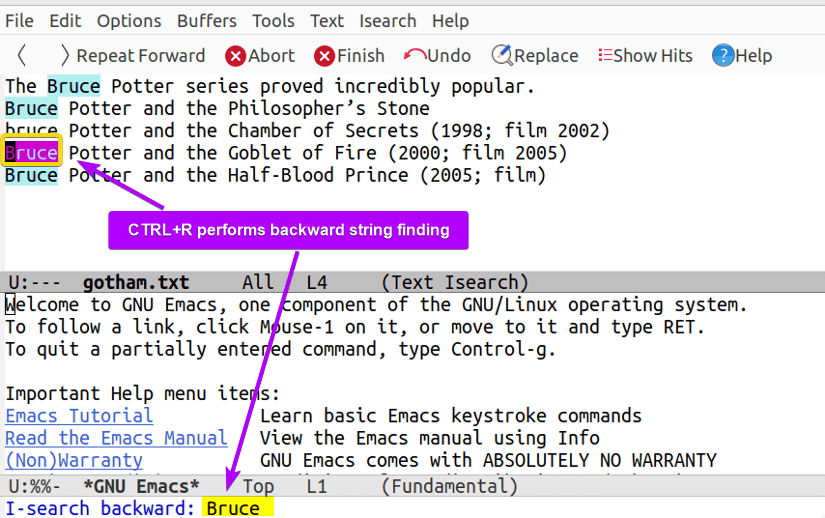
Moreover, Continuous pressing of CTRL+R performs incremental finding i.e. jumping through every match of the query string (Bruce, here, for example):
3. Find String with Regular Expressions Using CTRL+ALT+S
Emacs allows users to search and find queries using regular expressions (Regex). To find a pattern using a specific regular expression, press the keys CTRL+ALT+S and type the pattern when prompted: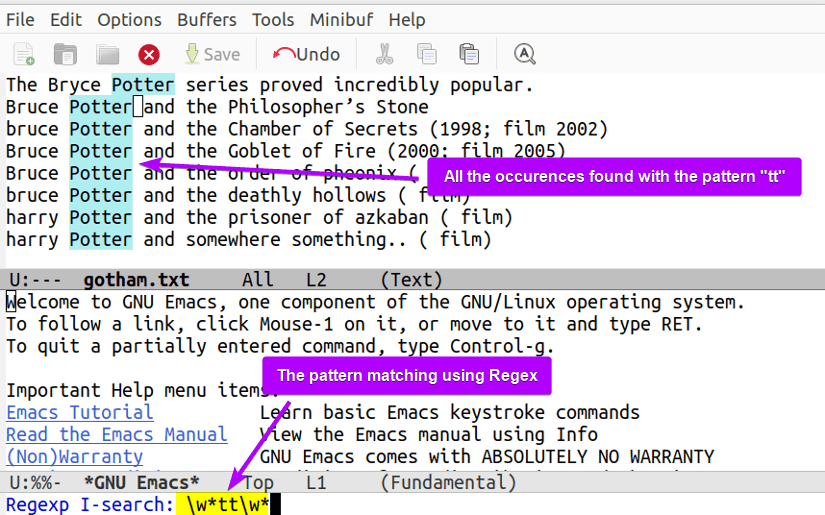
How to Find and Replace Text in Emacs
Apart from the finding feature, Emacs allows for quick replacement of the found query. There are several keyboard shortcuts for replacing the word in a text file. Emacs lets the users perform the operation query replace via find and replace which allows for finding a string and then replacing it.
To, replace text using Emacs in Linux, use the keyboard shortcut ALT+SHIFT+5 (also called ALT+% or M-%). After pressing ALT+SHIFT+5, Emacs will prompt you to enter the text to be replaced: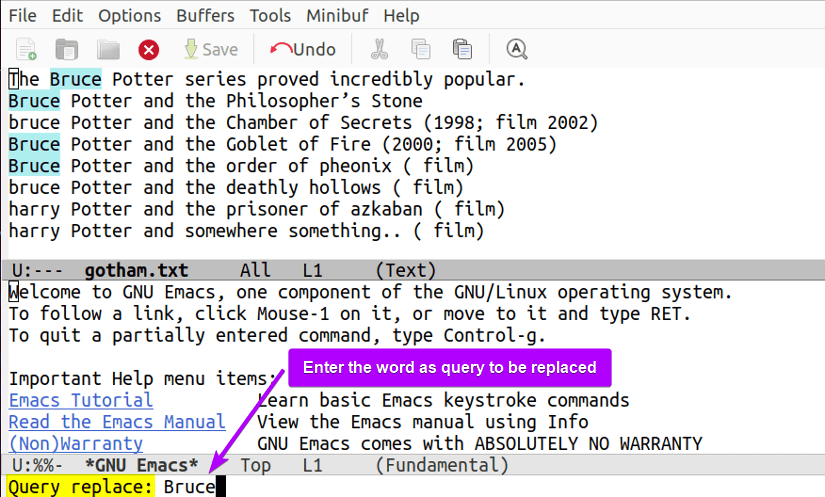
Now, Press ENTER and then type the new string that will replace the old queried string:

However, to replace all the occurrences of the query string (without asking for permission) press “!” (exclamation mark) once there’s a match: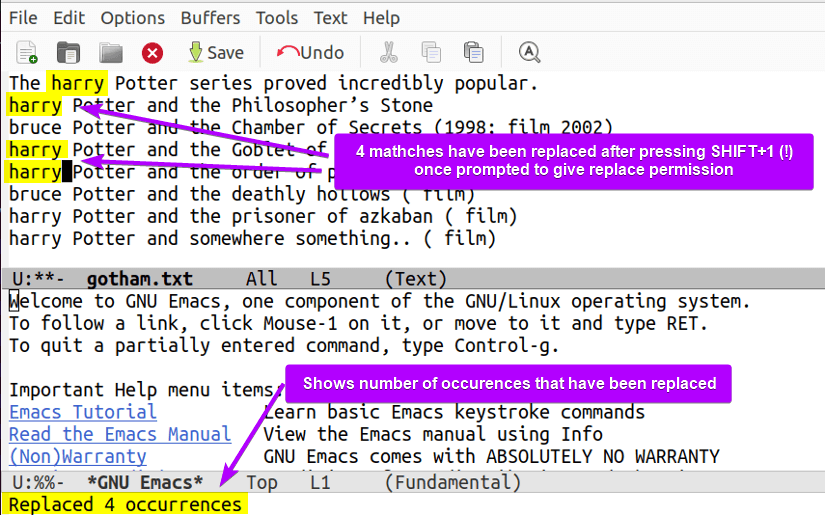
In addition, press N when prompted to replace if you wish not to replace any occurrence. Emacs will skip it and move to the next occurrence for permission (if it’s an incremental replacement):
Replace Text in Emacs with Regular Expressions
Similarly, Emacs can replace the matched pattern in a text by employing the regular expression technique. For example, consider the file gotham.txt:

Then, after pressing ENTER, type the new pattern to replace with and press ENTER:
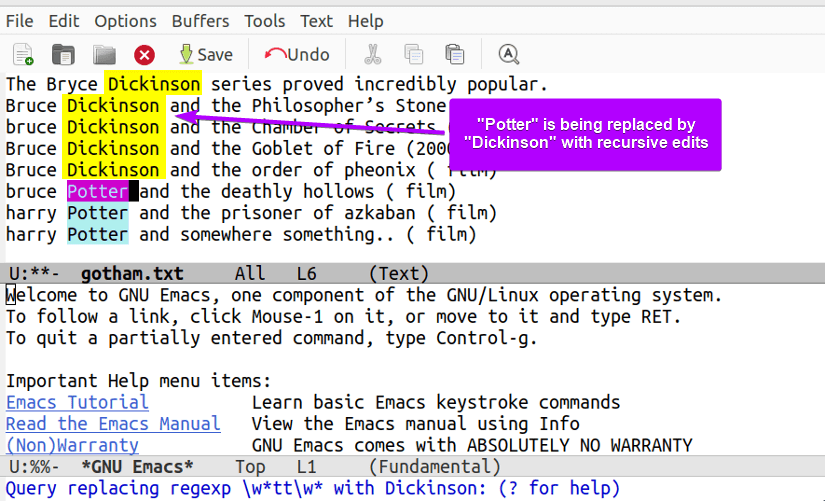
Additionally, to skip, quit, or replace all occurrences without asking, you know the gist.
Find and Replace in Emacs with GUI and Keyboard Shortcuts
The article, so far, has shown how to find and replace text in Emacs using keyboard shortcuts (also called keyboard bindings). Now, This section will introduce the GUI (Graphical User Interface)–based approaches to find and replace text using Emacs. Though this approach will also integrate keyboard shortcuts along with GUI, this combined approach will make text finding and replacing smoother and more user-friendly.
Now, in the case of GUI, there are some handy toolbar icons to find string and thus replace it:
The above image shows the toolbar icon Find for finding operations in Emacs. Simply click on the icon (instead of using CTRL+S) and type the string to find as before when prompted.
Now, once you type and search the query string, you can get the prompt to enter a new string by clicking on the “Replace” toolbar icon:
So, you can adopt this GUI and Keyboard shortcut combined method to find and replace words, and string patterns (you already know the gist) in Emacs.
Case-Sensitivity in Emacs Find and Replace
By default, Emacs performs case-sensitive searches but with some interesting behavior. Let’s explore them one by one and start by looking at the following image:
However, if you search using the lowercase “bruce”, then all the instances of the query string bruce will be selected (regardless of the case) since this time Emacs matches the query likely with the case-insensitive search: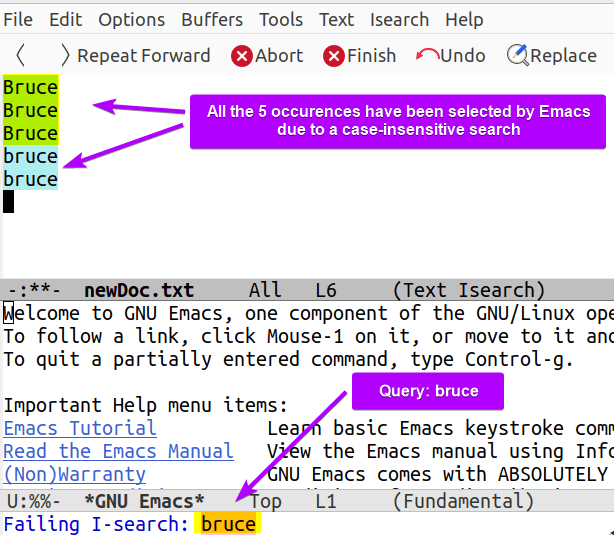
Conclusion
This article discusses How to find and replace strings from a text in Emacs in Linux. It mentioned different keyboard shortcuts to find words or strings and subsequently replace them with new ones. Moreover, it has shown finding and replacing of patterns using regular expressions. In addition, it has discussed the finding and replacing of strings using a combination of GUI and Key Bindings.
People Also Ask
How to find a specific string in Emacs?
To find a specific string in Emacs, Press CTRL+S and enter the query string when prompted. As a result, the words with a match will be highlighted so that you can easily locate the query string. In addition, to find a string using a regular expression, use the key binding CTRL+ALT+S.
Can I use GUI to find a specific text in the Emacs text editor?
Yes, you can use GUI to find a specific text in the Emacs text editor. Go to the toolbar menu of Emacs and click the icon that says Find (the icon with magnifying glass). Then enter the query string once prompted. As a result, the matched query will be highlighted. This is how Emacs lets you find a string using GUI.
How to find a specific file in the Emacs text editor in Linux?
To find a specific file in the Emacs text editor, press CTRL+X and then press CTRL+F. Then type the file name that you want to find once prompted. If the query file already exists, Emacs will open the file with a text buffer. However, if the file does not exist, Emacs will first create the file and then open it with a blank text buffer.
How to replace a string in the Emacs text editor?
To replace a string in the Emacs text editor, press ALT+SHIFT+5 (ALT+%) to first find the occurrence of the string. Emacs will prompt you to enter the string to find and replace. Once there’s a match, it will be highlighted. Now, press ENTER and type the word that will replace the found query. Again, press ENTER and press Y to replace the string in Emacs or press “!” (exclamation mark) to replace all the available matches without asking. Additionally, press N to skip replacing the current occurrence and CTRL+G to cancel the entire replacement process in Emacs. Moreover, you can replace using regular expressions by pressing CTRL+ALT+SHIFT+5.
Can I find a string backward search in Emacs?
Yes, you can find a string in Emacs using backward search. To find a string with a backward search in Emacs, press CTRL+R and enter the query string when prompted. Emacs will highlight the matched occurrences employing a backward search. To jump through all the matched occurrences, recursively press CTRL+R.
FUNDAMENTALS A Complete Guide for Beginners







